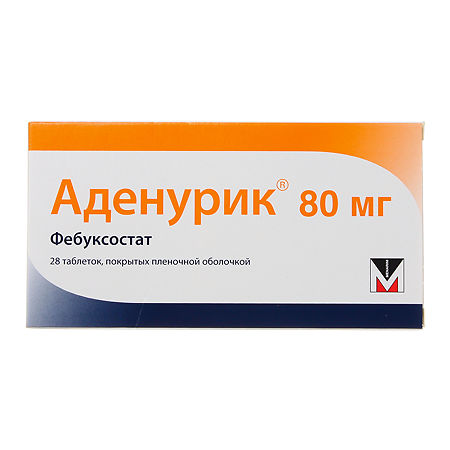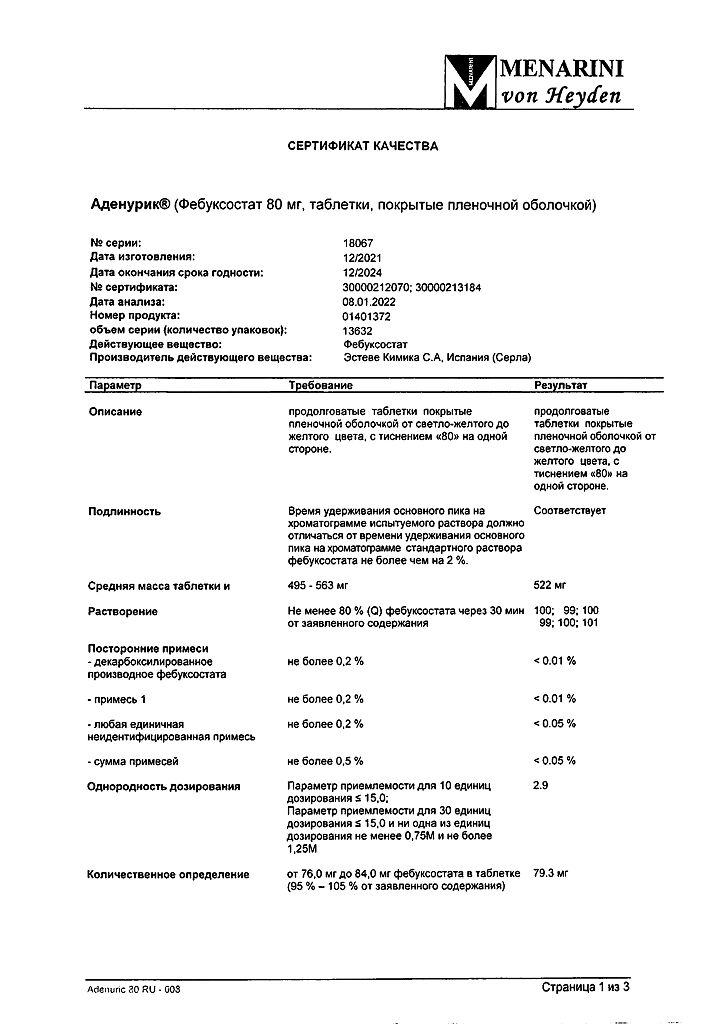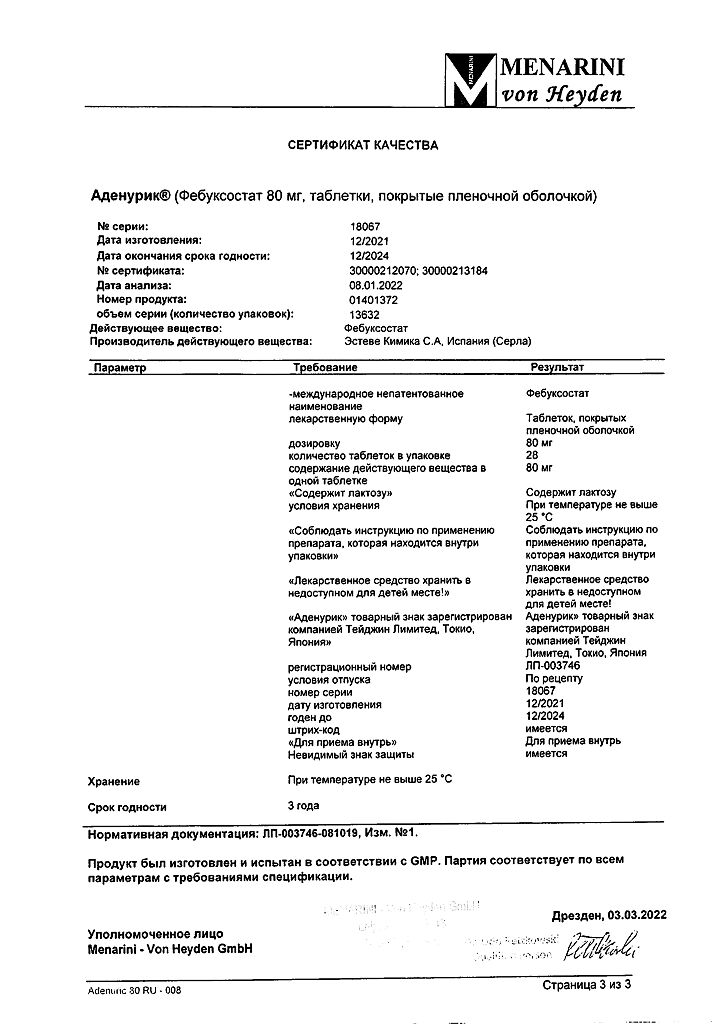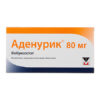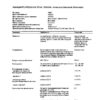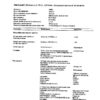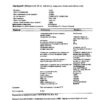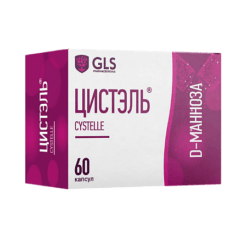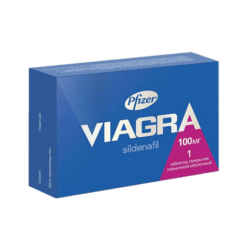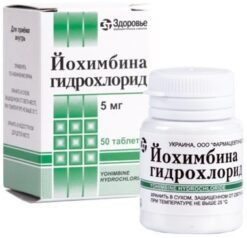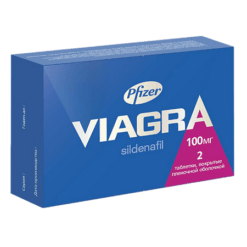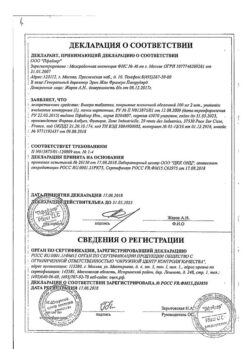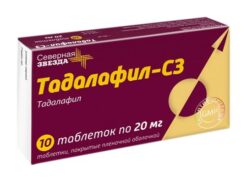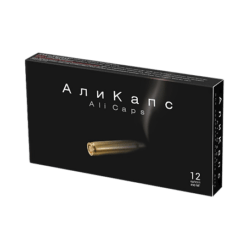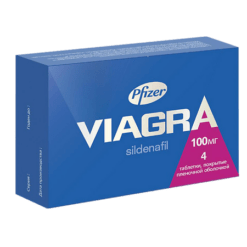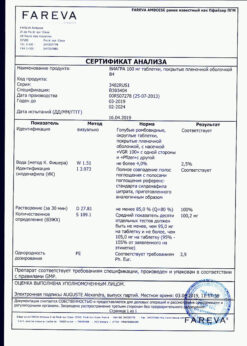No products in the cart.
Adenuric, 80 mg 28 pcs
€108.60 €90.50
Description
Antipodagrelating agent – xanthine oxidase inhibitor
Pharmacodynamics
. Uric acid is the end product of purine metabolism in the human body, formed as a result of the hypoxanthine-xanthine uric acid reaction cascade. Febuxostat is a 2-arylthiazole derivative and is a strong selective non-purine xanthine oxidase inhibitor (in vitro inhibition constant is less than 1 nM). The enzyme xanthine oxidase catalyzes two stages of purine metabolism: oxidation of hypoxanthine to xanthine and then oxidation of xanthine to uric acid.
As a result of selective inhibition of xanthine oxidase (oxidized and reduced forms) by febuxostat it causes decrease of uric acid concentration in blood serum.
In therapeutic concentrations febuxostat does not inhibit other enzymes involved in the metabolism of purines or pyrimidines, such as guanine deaminase, hypoxanguanine phosphorybosyltransferase, orotate phosphorybosyltransferase, oro-tidinmonophosphate decarboxylase or purine-nucleoside phosphorylase.
Clinical efficacy and safety profile
Gout
The efficacy and safety of febuxostat has been confirmed in three baseline phase III clinical studies involving 4,101 patients with hyperuricemia and gout ( APEX , FACT and CONFIRMS ).
In each of these studies, use of febuxostat resulted in a more effective reduction in uric acid concentration and maintenance of serum levels compared with allopurinol.
The primary endpoint in the APEX and FACT studies was the proportion of patients whose serum uric acid concentration did not exceed 6.0 mg/dL (357 μmol/L) during the past three months. In an additional CONFIRMS study, the primary endpoint was the proportion of patients whose serum uric acid concentration was less than 6.0 mg/dL at the last visit. These studies did not include patients who had undergone organ transplantation.
The double-blind, randomized, multicenter, 28-week APEX study (investigating the effectiveness of febuxostat versus placebo and allopurinol) enrolled 1,072 patients. Febuxostat was used in doses of 80 mg, 120 mg, or 240 mg once daily; allopurinol was used in a dose of 300 mg once daily in patients with baseline plasma creatinine ≤1.5 mg/dL and in a dose of 100 mg once daily in patients with baseline plasma creatinine >1.5 mg/dL and ≤2.0 mg/dL.
The use of febuxostat at a dose of 240 mg (twice the recommended maximum) was studied to evaluate the safety profile of febuxostat. When febuxostat was used at doses of 80 mg and 120 mg once daily for 28 weeks, the proportion of patients whose serum uric acid concentrations did not exceed 6.0 mg/dL (357 µmol/L) during the past three months was 48% and 65%, respectively, with allopurinol use at 22%. A double-blind, randomized, multicenter, 52-week FACT study (study of febuxostat versus allopurinol) enrolled 760 patients. Febuxostat was used in doses of 80 mg or 120 mg once daily; allopurinol was used in a dose of 300 mg once daily.
When febuxostat 80 mg and 120 mg once daily for 52 weeks, the proportion of patients whose serum uric acid concentrations did not exceed 6.0 mg/dL (357 µmol/L) during the past three months was 53% and 62%, respectively, and when allopurinol was used was 21%.
Administration of febuxostat led to a rapid decrease in plasma uric acid concentration; this effect persisted for a long time.
Decrease of uric acid concentration in blood serum less than 6.0 mg/dl (357 µmol/L) was noted as early as the second week of use (FACT study), this concentration was maintained throughout the period of febuxostat use.
A total of 2,269 patients were enrolled in the randomized, controlled, 26-week CONFIRMS study (studying the safety and effectiveness of febuxostat at doses of 40 mg and 80 mg once daily versus allopurinol at doses of 300 mg or 200 mg once daily in patients with gout and hyperuricemia). At least 65% of patients in this study had mild to moderate renal function impairment (creatinine clearance 30-89 mL/min).
The proportion of patients with plasma uric acid concentrations less than 6.0 mg/dL at the last visit was 45% and 67%, respectively, for febuxostat 40 mg and 80 mg, and 42% for allopurinol 300 mg/200 mg.
Extended long-term open-label studies
A three-year open-label, multicenter, randomized, expanded EXCEL safety study with allopurinol as a comparison included 1,086 patients (who completed the APEX or FACT study ) who were taking febuxostat at a dose of 80 mg once daily, febuxostat at 120 mg once daily or allopurinol 300 mg (for patients with baseline plasma creatinine ≤1.5 mg/dL) and 100 mg (for patients with baseline plasma creatinine >1.5 mg/dL and ≤2.0 mg/dL) once daily. Approximately 69% of patients did not require dose adjustment to establish a definitive stable regimen.
The target serum uric acid concentration level (less than 6.0 dL) achieved with prior febuxostat use did not change over time (91% and 93% of patients who initially took febuxostat at doses, respectively, 80 mg/mg and 120 mg, had serum uric acid concentrations less than 6.0 mg/dL at month 36 of use).
At three-year follow-up, there was a reduction in the incidence of gout attacks at months 16-24 and 30-36. Less than 4% of patients required treatment for an acute gout attack (i.e., more than 96% of patients did not need treatment for a gout attack). In 46% and 38% of patients taking febuxostat continuously, respectively, at a dose of 80 and 120 mg once daily, complete disappearance of tophi palpable at the initial visit was noted by the last visit.
The five-year open-label, multicenter, expanded safety study FOCUS (Phase II) included 116 patients who initially received febuxostat at a dose of 80 mg once daily for 4 weeks. In 62% of patients, no dose adjustment was required to maintain a target serum uric acid concentration of less than 6.0 mg/dL, and 38% of patients required dose adjustment to achieve target levels. At the last study visit, the proportion of patients whose serum uric acid concentration was less than 6.0 mg/dL (357 μmol/L) was greater than 80% (81-100%) at each study dose of febuxostat.
Effectiveness and safety profile in patients with impaired renal function
Febuxostat was used in 40 patients with impaired renal function (with creatinine >1.5 mg/dL and ≤2.0 mg/dL) in the APEX study. In patients with impaired renal function randomized to the allopurinol group, the dose of the latter was limited to 100 mg per day. In the febuxostat group, the primary endpoint was achieved in 44% of patients receiving febuxostat at a dose of 80 mg once daily, in 45% receiving 120 mg once daily, and in 60% receiving 240 mg once daily compared with 0% in the allopurinol group (100 mg once daily) and placebo group. There were no clinically significant differences in degree of decrease of uric acid concentration in blood serum in comparison with healthy volunteers (decrease of uric acid concentration in the group of patients with normal renal function was 58%, in the group with severe renal insufficiency – 55%).
A prospective analysis in the CONFIRMS study demonstrated significantly greater efficacy of febuxostat in reducing serum uric acid concentrations below 6 mg/dL, compared with allopurinol at a dose of 300 mg/ 200 mg in patients with gout and mild to moderate renal insufficiency (the proportion of these patients in the study was 65%).
The primary endpoint in a subgroup of patients with serum uric acid concentrations greater than 10 mg/dL
A baseline serum uric acid concentration greater than 10 mg/dL was noted in approximately 40% of patients enrolled in the APEX and FACT studies . Among these patients, the primary endpoint (uric acid concentration less than 6 mg/dL in the last 3 visits) was achieved in 41% of patients taking febuxostat at a dose of 80 mg once daily, in 48% of patients taking febuxostat at a dose of 120 mg once daily, and in 66% of patients taking febuxostat at a dose of 240 mg once daily compared with 9% in the allopurinol 300 mg/100 mg group and 0% in the placebo group.
According to the CONFIRMS study, the proportion of patients achieving the primary efficacy endpoint (uric acid concentration less than 6.0 mg/dL at the last visit) in the group of patients with a baseline serum uric acid concentration greater than 10 mg/dL receiving 40 mg febuxostat once daily was 27%, 80 mg once daily was 49% and 300 mg or 200 mg allopurinol once daily was 31%.
Percentage of patients needing treatment for an acute gout attack
The APEX Study: During the 8-week prevention period, a higher proportion of patients (36%) needed treatment for an acute gout attack in the group taking febuxostat at a dose of 120 mg daily than in the groups taking febuxostat at 80 mg (28%), allopurinol at 300 mg (23%) and the placebo group (20%). The incidence of acute gout attacks increased during the prophylactic period, subsequently decreasing over time. Between 46% and 55% of patients were treated for an acute gout attack from week 8 to week 28. Acute gout attacks during the last four weeks of the study (weeks 24-28) occurred in 15% of patients in the febuxostat group (80 mg, 120 mg), 14% of patients in the allopurinol group (300 mg), and 20% of patients in the placebo group.
The FACT Study : During the 8-week prophylactic period, a higher proportion of patients (36%) needed treatment for an acute gout attack in the group taking febuxostat at a dose of 120 mg daily than in the groups taking febuxostat at 80 mg daily (22%), allopurinol at 300 mg daily (21%). After an 8-week prophylactic period, the incidence of acute gout attacks increased and then gradually decreased over time (64% and 70% of patients were treated for gout exacerbations from weeks 8 through 52). Acute gout attacks during the last four weeks of the study (weeks 49-52) occurred in 6-8% of patients in the febuxostat group (80 mg, 120 mg), and in 11% of patients in the allopurinol group (300 mg).
The proportion of patients needing treatment for an acute gout attack (APEX and FACT studies ) was numerically lower in the groups with a mean serum uric acid concentration of less than 6.0 mg/dL, less than 5.0 mg/dL, or less than 0 mg/dL in the past 32 weeks (periods 20-24 weeks and 49-52 weeks) compared with the group where the mean serum uric acid concentration was greater than 6.0 mg/dL.
In the CONFIRMS study, the proportion of patients needing treatment for an acute gout attack (from day 1 to month 6) was 31% and 25% in the febuxostat 80 mg and allopurinol 200/300 mg groups, respectively. In the febuxostat 80 mg and febuxostat 40 mg groups, there were no differences between the proportions of patients needing treatment for an acute gout attack.
Tumor Decay Syndrome
The efficacy and safety of febuxostat for the prevention and treatment of tumor decay syndrome were studied in a randomized, double-blind phase III study, FLORENCE . Febuxostat demonstrated a more potent and rapid reduction in serum uric acid concentration compared to allopurinol with no adverse effect on renal function.
The study included 346 patients with hemoblastosis who had received cytostatic therapy and had a moderate to high risk of developing tumor decay syndrome. Patients received febuxostat at a dose of 120 mg once daily or allopurinol 200-600 mg daily to evaluate the ability of febuxostat to maintain serum uric acid concentration and to evaluate the effect of febuxostat on renal function. Patients who met the inclusion criteria for the study had to be candidates for allopurinol treatment or were unable to be treated with febuxostat.
The primary endpoints were the area under the concentration-time curve ( AUC ) of uric acid in serum and the change in serum creatinine over 8 days.
The mean area under the concentration-time curve was statistically significantly less in the febuxostat group than in the allopurinol group.
The mean serum uric acid concentration 24 hours after starting febuxostat and at all subsequent measurements was significantly lower than in the allopurinol group.
There were no statistically significant differences in the effect of febuxostat and allopurinol on plasma creatinine content.
The frequency of tumor decay syndrome with febuxostat and allopurinol was not statistically different either by laboratory diagnostic criteria or by clinical criteria.
The incidence of drug-related effects and the incidence of adverse reactions were 67.6% versus 64.7%, and 6.4% versus 6.4% in the febuxostat group and allopurinol group, respectively.
In the FLORENCE study in patients in whom allopurinol was planned, febuxostat demonstrated greater control of serum uric acid concentration compared with allopurinol. There are currently no data to compare febuxostat with rasburicase.
The efficacy and safety of febuxostat in patients with severe acute tumor decay syndrome (for example, in patients in whom other treatment regimens aimed at reducing uric acid concentration were ineffective) has not been studied.
Pharmacokinetics
A population-based analysis of pharmacokinetics and pharmacodynamics included data from a study involving 211 patients with hyperuricemia and gout who received febuxostat at a dose of 40 to 240 mg once daily. The obtained pharmacokinetic parameters of febuxostat were comparable to those of healthy volunteers, which allows us to consider the data of pharmacokinetic and pharmacodynamic studies involving healthy volunteers to be representative of the population of patients with gout.
Absorption
After oral administration, febuxostat is rapidly and almost completely (at least 84% of the dose taken) absorbed from the gastrointestinal tract. At multiple administration of febuxostat in dose of 80 mg or single dose of 120 mg concomitantly with fatty food maximum plasma concentration of febuxostat (C max ) was decreased by 49% and 38%, and AUC – by 18% and 16%, respectively. However, this had no effect on the clinical efficacy of decreasing uric acid concentration in blood serum (when taking febuxostat repeatedly at a dose of 80 mg), in this regard, febuxostat can be taken regardless of meals.
C max is reached 1.0-1.5 hours after oral administration and is 2.8-3.2 mcg/ml in a single oral dose of 80 mg and 5.0-5.3 mcg/ml in a single 120 mg dose. Absolute bioavailability of febuxostat in tablet form has not been studied.
No cumulation was observed in repeated oral administration of febuxostat in doses of 10 mg – 240 mg once daily.
Linearity/’non-linearity Pharmacokinetics
In healthy volunteers, Cmax and AUC increase linearly with increasing dose between 10 mg and 120 mg when administered once or repeatedly orally with febuxostat, and a greater than dose-proportional increase in AUC is noted in the dose range between 120 mg and 300 mg.
Distribution
The apparent volume of distribution at equilibrium ranges from 29 L to 75 L after oral administration of 10 to 300 mg of febuxostat. The degree of binding to plasma proteins (mainly to albumin) reaches 99.2%, and does not change when the dose is increased from 80 mg to 120 mg. For active metabolites the degree of binding to plasma proteins varies from 82% to 91%.
Metabolism
Febuxostat is metabolized by conjugation involving uridine diphosphate-glucuronyl transferase (UDFGT) and oxidation involving cytochrome P450 ( CYP ) enzymes. Four pharmacologically active hydroxyl metabolites have been isolated, of which three are found in human plasma. In in vitro studies on human liver microsomes showed that oxidized metabolites are formed predominantly under the influence of CYP 1 A 1, CYP 1 A 2, CYP 2 C 8 or CYP 2 C 9 isoenzymes, while febuxostat glucuronide is formed mainly under the influence of UGT 1A1, UGT 1A8 and UGT 1A9 isoenzymes.
Excretion
Febuxostat and its metabolites are excreted through the intestine and kidneys.
After oral administration of 14C radioisotope-labeled febuxostat at a dose of 80 mg, approximately 49% is excreted by the kidneys: unchanged – about 3%, as acyl glucuronide – 30%, as oxidized metabolites and their conjugates – 13%, as other metabolites – 3%.
About 45% of febuxostat is excreted through the intestine: as unchanged febuxostat – 12%, acylglucuronide – 1%, oxidized metabolites and their conjugates – 25%, other metabolites – 7%. Each half-life of febuxostat (T½) is 5-8 hours.
Farmacokinetics in special groups
Patients with renal impairment
Multiple oral doses of 80 mg febuxostat in patients with mild, moderate, or severe renal impairment did not change Cmax compared with healthy volunteers.
In patients with severe renal failure, the mean total AUC of febuxostat increased approximately 1.8-fold – (13.2 mcg/ml) compared to healthy volunteers (7.5 mcg h/ml); Cmax and AUC of pharmacologically active febuxostat metabolites increased 2 and 4-fold, respectively. Thus, in patients with renal insufficiency of mild or moderate severity no dose adjustment of the drug is required.
Patients with hepatic insufficiency
No significant changes in Cmax and AUC of febuxostat and its metabolites in patients with mild hepatic insufficiency (Child-Pugh class A: 5-6 points) and moderate (Child-Pugh class B: 7-9 points) severity compared to healthy volunteers. No studies of febuxostat pharmacokinetics have been conducted in patients with severe hepatic impairment (Child-Pugh grade C: 10-15 points).
Elderly age
No significant changes in the AUC of febuxostat and its metabolites were observed in elderly patients compared to young healthy volunteers during multiple oral administration of febuxostat.
Gender
In repeated oral administration of febuxostat, the Cmax and AUC of febuxostat were 24% and 12% higher in women than in men, respectively. However, the Cmax and AUC values adjusted for patient weight were similar for both groups. Thus, there is no need to adjust the dose of the drug depending on the gender of the patient.
Indications
Indications
Chronic hyperuricemia in conditions accompanied by deposition of urate crystals (in the presence of tophi and/or gouty arthritis, including a history).
Treatment and prevention of hyperuricemia in adult patients during cytostatic therapy of hemoblastoses with a moderate to high risk of developing tumor collapse syndrome (only for a dosage of 120 mg).
Adenuric® is intended for use in adults.
Pharmacological effect
Pharmacological effect
Antigout drug – xanthine oxidase inhibitor
Pharmacodynamics
Uric acid is the end product of purine metabolism in the human body, formed as a result of a cascade of hypoxanthine-xanthine-uric acid reactions. Febuxostat is a 2-arylthiazole derivative and is a potent, selective, non-purine xanthine oxidase inhibitor (in vitro inhibition constant less than 1 nM). The enzyme xanthine oxidase catalyzes two stages of purine metabolism: the oxidation of hypoxanthine to xanthine, and then the oxidation of xanthine to uric acid.
As a result of selective inhibition of xanthine oxidase (oxidized and reduced forms) by febuxostat, the concentration of uric acid in the blood serum decreases.
At therapeutic concentrations, febuxostat does not inhibit other enzymes involved in purine or pyrimidine metabolism, such as guanine deaminase, hypoxanthine guanine phosphoribosyltransferase, orotate phosphoribosyltransferase, orotidine monophosphate decarboxylase, or purine nucleoside phosphorylase.
Clinical efficacy and safety profile
Gout
The efficacy and safety of febuxostat was confirmed in three pivotal phase III clinical trials involving 4101 patients with hyperuricemia and gout (APEX, FACT and CONFIRMS).
In each of these studies, febuxostat was more effective in lowering and maintaining serum uric acid levels than allopurinol.
The primary endpoint in the APEX and FACT studies was the proportion of patients whose serum uric acid concentration did not exceed 6.0 mg/dL (357 μmol/L) over the past three months. In the CONFIRMS substudy, the primary endpoint was the proportion of patients whose serum uric acid concentration was less than 6.0 mg/dL at the last visit. These studies did not include patients who had undergone organ transplantation.
The APEX (febuxostat versus placebo and allopurinol) study included 1072 patients in the double-blind, randomized, multicenter, 28-week APEX trial. Febuxostat was used at doses of 80 mg, 120 mg, or 240 mg once daily; allopurinol – at a dose of 300 mg once daily in patients with initial plasma creatinine ≤1.5 mg/dL and at a dose of 100 mg once daily in patients with initial plasma creatinine >1.5 mg/dL and ≤2.0 mg/dL.
The use of febuxostat at a dose of 240 mg (twice the recommended maximum) was studied to evaluate the safety profile of febuxostat. When using febuxostat in doses of 80 mg and 120 mg once daily for 28 weeks, the proportion of patients whose serum uric acid concentration did not exceed 6.0 mg/dL (357 μmol/L) during the last three months was 48% and 65%, respectively, when using allopurinol – 22%. The FACT (Febuxostat Versus Allopurinol Trial) trial enrolled 760 patients in a double-blind, randomized, multicenter, 52-week trial. Febuxostat was used at doses of 80 mg or 120 mg once daily, allopurinol was used at a dose of 300 mg once daily.
When using febuxostat 80 mg and 120 mg once daily for 52 weeks, the proportion of patients whose serum uric acid concentration did not exceed 6.0 mg/dL (357 μmol/L) during the last three months was 53% and 62%, respectively, and when using allopurinol – 21%.
The use of febuxostat led to a rapid decrease in plasma uric acid concentrations; this effect persisted for a long time.
A decrease in serum uric acid concentration of less than 6.0 mg/dL (357 µmol/L) was observed already in the second week of use (FACT study), this concentration remained throughout the entire period of use of febuxostat.
The CONFIRMS (Study of the Safety and Efficacy of Febuxostat 40 mg and 80 mg once daily versus Allopurinol 300 mg or 200 mg once daily in Patients with Gout and Hyperuricemia) randomized, controlled, 26-week study included 2269 patients. At least 65% of patients in this study had mild to moderate renal impairment (creatinine clearance 30-89 ml/min).
When using febuxostat at a dose of 40 mg and 80 mg, the proportion of patients whose plasma uric acid concentration was less than 6.0 mg/dL at the last visit was 45% and 67%, respectively, for allopurinol 300 mg/200 mg – 42%.
Extended long-term open-label studies
The three-year, open-label, multicenter, randomized extension safety study EXCEL with allopurinol included 1,086 patients (who completed the APEX or FACT study) who received febuxostat 80 mg once daily, febuxostat 120 mg once daily; or allopurinol 300 mg (for patients with initial plasma creatinine ≤1.5 mg/dL) and 100 mg (for patients with initial plasma creatinine >1.5 mg/dL and ≤2.0 mg/dL) once daily. Approximately 69% of patients did not require dose adjustment to establish a final stable dosage regimen.
The target serum uric acid concentration (less than 6.0 dL) achieved with prior use of febuxostat did not change over time (91% and 93% of patients initially taking febuxostat at doses of 80 mg/mg and 120 mg, respectively, had serum uric acid concentrations less than 6.0 mg/dL at 36 months of use).
According to three-year follow-up, there was a decrease in the incidence of gout attacks at 16-24 months and 30-36 months. Less than 4% of patients required treatment for acute gout attacks (i.e., more than 96% of patients did not require treatment for gout attacks). In 46% and 38% of patients continuously taking febuxostat, respectively, at a dose of 80 and 120 mg once daily, by the last visit, complete disappearance of the tophi palpated at the initial visit was noted.
The five-year, open-label, multicenter, Phase II safety extension study FOCUS included 116 patients who initially received febuxostat 80 mg once daily for 4 weeks. In 62% of patients, no dose adjustment was required to maintain a target serum uric acid concentration of less than 6.0 mg/dL, and 38% of patients required a dose adjustment to achieve the target level. At the last study visit, the proportion of patients whose serum uric acid concentration was less than 6.0 mg/dL (357 μmol/L) was more than 80% (81-100%) at each febuxostat dose studied.
Efficacy and safety profile in patients with impaired renal function
In the APEX study, febuxostat was used in 40 patients with renal impairment (creatinine >1.5 mg/dL and ≤2.0 mg/dL). In patients with impaired renal function randomized to the allopurinol group, the dose of the latter was limited to 100 mg per day. In the febuxostat group, the primary endpoint was met in 44% of patients receiving febuxostat 80 mg once daily, 45% receiving 120 mg once daily, and 60% of patients receiving 240 mg once daily, compared with 0% in the allopurinol (100 mg once daily) and placebo groups. There were no clinically significant differences in the degree of decrease in the concentration of uric acid in the blood serum compared with healthy volunteers (the decrease in uric acid concentration in the group of patients with normal renal function was 58%, in the group with severe renal failure – 55%).
A prospective analysis in the CONFIRMS study demonstrated that febuxostat was significantly more effective in reducing serum uric acid concentrations to less than 6 mg/dL compared with allopurinol 300 mg/200 mg in patients with gout and mild to moderate renal impairment (65% of patients in the study).
Primary endpoint in the subgroup of patients with serum uric acid concentrations greater than 10 mg/dL
Baseline serum uric acid concentrations greater than 10 mg/dL were observed in approximately 40% of patients included in the APEX and FACT studies. Among these patients, the primary endpoint (uric acid concentration less than 6 mg/dL in the last 3 visits) was achieved in 41% of patients receiving febuxostat 80 mg once daily, 48% of patients receiving febuxostat 120 mg once daily, and 66% of patients receiving febuxostat 240 mg once daily compared with 9% in the allopurinol 300 mg/100 mg group, and 0% in the placebo group.
According to the CONFIRMS study, the proportion of patients achieving the primary efficacy endpoint (uric acid concentration less than 6.0 mg/dL at the last visit) in the group of patients with baseline serum uric acid concentration more than 10 mg/dL receiving 40 mg febuxostat once daily was 27%, 80 mg once daily was 49%, and 300 mg or 200 mg allopurinol. once a day -31%.
Proportion of patients requiring treatment for an acute attack of gout
APEX Study: During the 8-week prophylaxis period, a higher proportion of patients (36%) required treatment for an acute attack of gout in the febuxostat 120 mg daily group than in the febuxostat 80 mg (28%), allopurinol 300 mg (23%) and placebo (20%) groups. During the prophylactic period, the incidence of acute gout attacks increased, subsequently decreasing over time. Between 46% and 55% of patients were treated for an acute gout attack from weeks 8 to 28. Acute attacks of gout during the last four weeks of the study (weeks 24-28) occurred in 15% of patients in the febuxostat group (80 mg, 120 mg), in 14% of patients in the allopurinol group (300 mg), and in 20% of patients in the placebo group.
FACT Study: During the 8-week prophylaxis period, a higher proportion of patients in the febuxostat 120 mg daily group required treatment for an acute attack of gout (36%) than in the febuxostat 80 mg daily group (22%) and allopurinol 300 mg daily (21%). After the 8-week prophylaxis period, the incidence of gout flares increased and then gradually decreased over time (64% and 70% of patients were treated for gout flares from weeks 8 to 52). Acute attacks of gout during the last four weeks of the study (weeks 49-52) occurred in 6-8% of patients in the febuxostat group (80 mg, 120 mg), and in 11% of patients in the allopurinol group (300 mg).
The proportion of patients requiring treatment for an acute attack of gout (APEX and FACT studies) was numerically lower in groups that achieved a mean serum uric acid concentration of less than 6.0 mg/dL, less than 5.0 mg/dL, or less than 0 mg/dL during the last 32 weeks (periods 20–24 and 49–52 weeks), compared with the group where the mean serum uric acid concentration was more than 6.0 mg/dl.
In the CONFIRMS study, the proportion of patients requiring treatment for an acute gout attack (day 1 to month 6) was 31% and 25% in the febuxostat 80 mg group and allopurinol 200/300 mg group, respectively. In the febuxostat 80 mg and febuxostat 40 mg groups, there was no difference between the proportions of patients requiring treatment for an acute attack of gout.
Tumor collapse syndrome
The efficacy and safety of febuxostat for the prevention and treatment of tumor collapse syndrome were studied in a randomized, double-blind phase III study – FLORENCE. Febuxostat demonstrated a more potent and rapid reduction in serum uric acid concentrations compared to allopurinol, without adversely affecting renal function.
The study included 346 patients with hematologic malignancies who received cytostatic therapy and who had a moderate to high risk of developing tumor collapse syndrome. Patients received febuxostat 120 mg once daily or allopurinol 200-600 mg daily to evaluate the ability of febuxostat to maintain serum uric acid concentrations and to evaluate the effect of febuxostat on renal function. Patients eligible for inclusion in the study must have been candidates for treatment with allopurinol or not eligible for treatment with rasburicase.
Primary endpoints were: area under the concentration-time curve (AUC) of serum uric acid and change in serum creatinine over 8 days.
The mean area under the concentration-time curve was statistically significantly lower in the febuxostat group than in the allopurinol group.
The mean serum uric acid concentration 24 hours after initiation of febuxostat and at all subsequent measurements was significantly lower than in the allopurinol group.
There were no statistically significant differences in the effects of febuxostat and allopurinol on plasma creatinine levels.
The incidence of tumor collapse syndrome with the use of febuxostat and allopurinol was not statistically different according to either laboratory diagnostic criteria or clinical criteria.
The incidence of drug-related effects and adverse reactions was 67.6% versus 64.7%, and 6.4% versus 6.4% in the febuxostat group and the allopurinol group, respectively.
In the FLORENCE study, febuxostat demonstrated greater control of serum uric acid concentrations compared with allopurinol in patients scheduled to receive allopurinol. There are currently no data available to compare febuxostat with rasburicase.
The efficacy and safety of febuxostat in patients with severe acute tumor collapse syndrome (for example, in patients in whom other treatment regimens aimed at reducing uric acid concentrations have failed) have not been studied.
Pharmacokinetics
The population pharmacokinetics and pharmacodynamics analysis included data obtained from a study of 211 patients with hyperuricemia and gout who received febuxostat 40 to 240 mg once daily. The obtained pharmacokinetic parameters of febuxostat were comparable to those in healthy volunteers, which allows us to consider the data from pharmacokinetics and pharmacodynamics studies in healthy volunteers to be representative of the population of patients with gout.
Suction
After oral administration, febuxostat is rapidly and almost completely (at least 84% of the dose taken) absorbed from the gastrointestinal tract. With multiple doses of febuxostat at a dose of 80 mg or a single dose of 120 mg simultaneously with a fatty meal, the maximum plasma concentration of febuxostat (Cmax) decreased by 49% and 38%, respectively, and AUC by 18% and 16%, respectively. However, this did not affect the clinical effectiveness of reducing the concentration of uric acid in the blood serum (with repeated doses of febuxostat at a dose of 80 mg), and therefore febuxostat can be taken regardless of meals.
Cmax is achieved 1.0-1.5 hours after oral administration and is 2.8-3.2 mcg/ml with a single oral dose of 80 mg and 5.0-5.3 mcg/ml with a single dose of 120 mg. The absolute bioavailability of febuxostat in tablet form has not been studied.
With repeated oral administration of febuxostat in doses of 10 mg – 240 mg once a day, no accumulation was observed.
Linearity/’nonlinearity Pharmacokinetics
In healthy volunteers, with single or multiple oral doses of febuxostat, Cmax and AUC increase linearly with increasing doses in the 10 mg to 120 mg dose range, and in the 120 mg to 300 mg dose range, there is a more than dose proportional increase in AUC.
Distribution
The apparent volume of distribution at steady state varies from 29 L to 75 L after oral administration of 10 to 300 mg febuxostat. The degree of binding to plasma proteins (mainly albumin) reaches 99.2%, and does not change when the dose is increased from 80 mg to 120 mg. For active metabolites, the degree of binding to plasma proteins varies from 82% to 91%.
Metabolism
Febuxostat is metabolized by conjugation with the participation of uridine diphosphate glucuronyl transferase (UDPGT) and oxidation with the participation of enzymes of the cytochrome P450 system (CYP). Four pharmacologically active hydroxyl metabolites have been isolated, of which three are found in human plasma. In vitro studies on human liver microsomes have shown that oxidized metabolites are formed predominantly by the isoenzymes CYP 1 A 1, CYP 1 A 2, CYP 2 C 8 or CYP 2 C 9, while febuxostat glucuronide is formed mainly by the isoenzymes UGT 1A1, UGT 1A8 and UGT 1A9.
Selection
Febuxostat and its metabolites are excreted from the body through the intestines and kidneys.
After oral administration of febuxostat, labeled with a 14C radioisotope at a dose of 80 mg, approximately 49% is excreted by the kidneys: unchanged – about 3%, in the form of acyl glucuronide – 30%, in the form of oxidized metabolites and their conjugates – 13%, in the form of other metabolites – 3%.
Approximately 45% of febuxostat is excreted through the intestine: as unchanged febuxostat – 12%, acyl glucuronide – 1%, oxidized metabolites and their conjugates – 25%, other metabolites – 7%. The apparent half-life of febuxostat (T½) is 5-8 hours.
Pharmacokinetics in special groups
Patients with renal failure
With repeated oral administration of febuxostat at a dose of 80 mg in patients with mild, moderate or severe renal failure, Cmax did not change compared to healthy volunteers.
In patients with severe renal failure, the mean total AUC of febuxostat increased approximately 1.8-fold (13.2 mcg h/ml) compared to healthy volunteers (7.5 mcg h/ml); Cmax and AUC of pharmacologically active metabolites of febuxostat increased 2 and 4 times, respectively. Thus, in patients with mild or moderate renal failure, no dose adjustment is required.
Patients with liver failure
With repeated oral administration of febuxostat at a dose of 80 mg, there were no significant changes in the Cmax and AUC of febuxostat and its metabolites in patients with mild (Child-Pugh class A: 5-6 points) and moderate (Child-Pugh class B: 7-9 points) liver failure compared with healthy volunteers. The pharmacokinetics of febuxostat have not been studied in patients with severe hepatic impairment (Child-Pugh class C: 10-15 points).
Old age
With repeated oral administration of febuxostat, there were no significant changes in the AUC of febuxostat and its metabolites in elderly patients compared to young healthy volunteers.
Gender
With repeated oral administration of febuxostat, the Cmax and AUC of febuxostat in women were, respectively, 24% and 12% higher than in men. However, Cmax and AUC values adjusted for patient body weight were similar for both groups. Thus, no dose adjustment is required depending on the patient’s gender.
Special instructions
Special instructions
Acute attack of gout
The use of Adenuric® should be started only after an acute attack of gout has subsided. Starting to use the drug Adenuric® can provoke the development of an acute attack of gout due to the release of urates from tissue depots and a subsequent increase in the concentration of uric acid in the blood serum.
To prevent gout attacks, in the absence of contraindications, simultaneous use of NSAIDs or colchicine for at least 6 months is recommended.
If an attack develops while using the drug Adenuric®, the use of the drug should be continued and, at the same time, appropriate treatment of an acute attack of gout should be carried out.
With long-term use of the drug Adenuric®, the frequency and severity of gout attacks decrease.
Xanthine deposition
In rare cases, in patients with accelerated urate formation (for example, against the background of malignant neoplasms or Lesch-Nyhan syndrome), a significant increase in the absolute concentration of xanthines in the urine may occur, which may be accompanied by their deposition in the urinary tract.
This phenomenon was not observed when febuxostat was used in the FLORENCE study in patients with tumor collapse syndrome. Due to limited data, the use of Adenuric® in patients with Lesch-Nyhan syndrome is not recommended.
Mercaptopurine/azathioprine
Concomitant use with mercaptopurine and azathioprine is not recommended. If simultaneous use is necessary, to reduce the toxic effect on the hematopoietic system, it is recommended to reduce the dose of mercaptopurine/azathioprine and careful medical monitoring.
Theophylline
With simultaneous use of febuxostat in healthy volunteers at a dose of 80 mg 1 time per day and a single dose of theophylline 400 mg, no changes in pharmacokinetic parameters were observed. Thus, the simultaneous use of febuxostat at a dose of 80 mg and theophylline does not carry the risk of increasing the concentration of theophylline in the blood plasma. Concomitant use of febuxostat 120 mg and theophylline has not been studied.
Patients who have undergone organ transplantation
The use of Adenuric® in patients who have undergone organ transplantation is not recommended due to the lack of experience with its use.
Allergic reactions and hypersensitivity reactions
During post-marketing use, there have been rare reports of severe allergic reactions (hypersensitivity reactions), including Stevens-Johnson syndrome, toxicodermal necrolysis, anaphylactic reactions and shock.
In most cases, these reactions developed during the first month of using Adenuric®. Some patients had a history of renal failure and/or hypersensitivity reactions due to the use of allopurinol.
In isolated cases, severe hypersensitivity reactions, including drug reaction syndrome with eosinophilia and systemic symptoms (DRESS), were accompanied by fever, changes in blood counts, and impaired liver or kidney function.
Patients should be informed of the possible signs and symptoms of allergic reactions (hypersensitivity reactions), and should be closely monitored for the development of symptoms of allergic reactions/hypersensitivity reactions.
In the event of severe allergic/hypersensitivity reactions, including Stevens-Johnson syndrome, it is necessary to immediately stop using Adenuric® (earlier discontinuation is associated with a better prognosis). Repeated use of the drug is not recommended.
Cardiovascular diseases
The use of Adenuric® is not recommended in patients with coronary heart disease or congestive heart failure.
In the APEX and FACT studies (as opposed to the CONFIRMS study), in the overall febuxostat group compared with the allopurinol group, there was an increase in the number of cardiovascular events defined in accordance with the system developed by the Collaborative Analysis of Antiplatelet Therapy Group (CAAT) and including death from cardiovascular causes, non-fatal myocardial infarction, non-fatal stroke) – 1.3 compared with 0.3 cases per 100 patient-years.
Pooled data from phase III clinical trials (APEX, FACT and CONFIRMS studies) showed an incidence of 0.7 cardiovascular events compared with 0.6 per 100 patient-years.
In long-term large-scale studies, the incidence of cardiovascular disorders of HCAAT was 1.2 and 0.6 cases per 100 patient-years for febuxostat and allopurinol, respectively. The differences were not statistically significant, and a cause-and-effect relationship between these disorders and the use of febuxostat was not established.
A history of the following conditions was identified as risk factors for the development of these events in patients: atherosclerosis and/or myocardial infarction, or congestive heart failure.
Prevention and treatment of hyperuricemia in patients at risk of developing tumor collapse syndrome
In patients receiving cytostatic therapy for hemoblastoses with a risk of developing moderate to severe tumor collapse syndrome, the use of Adenuric®, if indicated, should be carried out under the supervision of a cardiologist.
Liver diseases
According to pooled data from phase III clinical trials, mild liver dysfunction was observed in 5% of patients using febuxostat.
Before prescribing Adenuric®, it is recommended to assess liver function, and, if indicated, also during use.
Thyroid diseases
In extended long-term open studies with long-term use of febuxostat, 5.5% of patients experienced an increase in the concentration of thyroid-stimulating hormone (>5.5 μIU/ml), and therefore Adenuric® should be prescribed with caution to patients with impaired thyroid function.
The drug Adenurik® contains lactose, therefore its use in patients with lactase deficiency, hereditary lactose intolerance, glucose-galactose malabsorption syndrome is contraindicated.
Impact on the ability to drive vehicles and operate machinery
When taking the drug Adenurik®, drowsiness, dizziness, paresthesia and blurred vision may occur, and, as a result, a decrease in reaction and ability to concentrate, therefore, while using the drug Adenurik®, you must be careful when driving vehicles and engaging in other potentially hazardous activities that require concentration and speed of psychomotor reactions.
Active ingredient
Active ingredient
Febuxostat
Composition
Composition
Core:
Active ingredient:
febuxostat – 80.0 mg.
Excipients:
lactose monohydrate – 76.50 mg,
hyprolose – 12.00 mg,
microcrystalline cellulose (Avicel PH 101) – 129.00 mg,
microcrystalline cellulose (Avicel PH 102) – 172.50 mg,
croscarmellose sodium – 25.00 mg,
magnesium stearate – 2.50 mg,
colloidal silicon dioxide aqueous – 2.50 mg.
Film casing:
opadry®II yellow 85 F 42129, consisting of: polyvinyl alcohol, titanium dioxide (E 171), macrogol 3350, talc, yellow iron oxide dye (E 172) – 20.84 mg.
Contraindications
Contraindications
– hypersensitivity to febuxostat and/or any of the excipients;
– children under 18 years of age;
– pregnancy and breastfeeding period;
– hereditary galactose intolerance, lactase deficiency and glucose and galactose malabsorption syndrome.
With caution:
– severe renal failure (creatinine clearance <30 ml/min) (efficacy and safety have not been sufficiently studied);– liver failure;– history of allergic reactions;– coronary heart disease;– congestive heart failure;– diseases of the thyroid gland;– simultaneous use with mercaptopurine/azathioprine (possibly increasing the concentration of these substances in the blood plasma and increasing their toxicity);– conditions after organ transplantation (experience with febuxostat is limited);– Lesch-Nyhan syndrome (experience with febuxostat is limited).
Side Effects
Side Effects
Taking into account the different nature of the course of gout and tumor decay syndrome, side effects when using febuxostat for these nosologies of action are presented separately.
Gout
The most common side effects in patients with gout when using febuxostat based on the results of clinical studies (4072 patients taking febuxostat at a dose of 10 mg to 300 mg) and according to post-marketing surveillance data were: gout attack, liver dysfunction, diarrhea, headache, nausea, skin rash and swelling. In most cases, these phenomena were characterized by mild or moderate severity.
During post-marketing surveillance, rare cases of hypersensitivity reactions to febuxostat, accompanied in some cases by systemic symptoms, have been reported.
Possible side effects are listed below according to the World Health Organization classification in descending frequency of occurrence: very common (≥1/10); often (≥1/100, < 1/10), uncommon (≥1/1000, < 1/100), rare (≥1/10000, < 1/1000), very rare (< 1/10000), including isolated reports.The incidence of side effects is based on clinical trial data and post-marketing experience with febuxostat.From the blood and lymphatic systemRare: pancytopenia, thrombocytopenia.From the immune systemRare: anaphylactic reactions*, hypersensitivity reactions*.From the nervous systemOften: headache;Uncommon: dizziness, paresthesia, hemiparesis, drowsiness, changes in taste perception, hyposthesia, hyposmia (decreased sense of smell).From the endocrine systemUncommon: increased concentration of thyroid-stimulating hormone (TSH) in blood plasma.Metabolism and nutritionCommon: gout attacks***;Uncommon: diabetes mellitus, hyperlipidemia, decreased appetite, weight gain;Rarely: weight loss, increased appetite, anorexia.From the mental sideUncommon: decreased libido, insomnia;Rarely: nervousness.From the side of the organ of visionRare: blurred vision.From the side of swearing, hearing and labyrinthine disordersRare: tinnitus.From the side of the heartUncommon: atrial fibrillation, palpitations, ECG changes, left bundle branch block (see section “Tumor Decay Syndrome”), sinus tachycardia (see section “Tumor Decay Syndrome”).From the side of blood vesselsUncommon: increased blood pressure, flushing of the face, feeling of heat, hemorrhage (see section “Tumor Collapse Syndrome”).From the respiratory system, chest organs and mediastinumUncommon: dyspnea, bronchitis, upper respiratory tract infection, cough, chest pain, chest discomfort.From the digestive tractCommon: diarrhea**, nausea;Uncommon: abdominal pain, bloating, gastroesophageal reflux disease, vomiting, dry oral mucosa, dyspeptic symptoms, constipation, frequent bowel movements, flatulence, abdominal discomfort;Rarely: pancreatitis, ulcerative stomatitis.From the liver and biliary tractCommon: liver dysfunction**;Uncommon: cholelithiasis;Rare: hepatitis, jaundice*, liver damage*.From the skin and subcutaneous tissuesCommon: skin rash (including the various types of rash mentioned below with lower frequency);Uncommon: dermatitis, urticaria, pruritus, skin discoloration, skin lesions, petechiae, macular rash, maculopapular rash, papular rash;Rarely: toxic dermal necrolysis*, Stevens-Johnson syndrome*, angioedema*, drug reaction with eosinophilia and systemic symptoms* (see section “Special Instructions”), severe forms of generalized rash*, erythema, exfoliative rash, follicular rash, vesicular rash, pustular rash, pruritic rash*, erythematous rash, morbilliform rash, alopecia, hyperhidrosis.From the musculoskeletal systemUncommon: arthralgia, arthritis, myalgia, musculoskeletal pain, muscle weakness, muscle spasm, muscle tension, bursitis;Rare: rhabdomyolysis*, joint stiffness, muscle stiffness.Renal and urinary tract disordersUncommon: renal failure, nephrolithiasis, hematuria, pollakiuria, proteinuria;Rare: tubulointerstitial nephritis*, urinary urgency.From the reproductive systemUncommon: erectile dysfunction.General disorders:Often: swelling;Uncommon: increased fatigue;Rare: thirst.Influence on the results of laboratory and instrumental studiesUncommon: increased plasma amylase activity, decreased platelet count, decreased leukocyte count, decreased lymphocyte count, increased plasma creatine and creatinine, decreased hemoglobin, increased plasma urea concentration, increased plasma triglyceride concentration, increased plasma cholesterol concentration, decreased hematocrit, increased plasma lactate dehydrogenase activity, increased plasma potassium content blood.Rarely: increased concentration of glucose in the blood plasma, prolongation of the activated partial thromboplastin time, decreased number of red blood cells, increased activity of alkaline phosphatase in the blood plasma.* Side effects observed during post-marketing surveillance.**Noninfectious diarrhea and liver disorders observed in phase III studies were more common with concomitant use of colchicine.***Additional information regarding the development of acute attacks of gout in the “Special Instructions” section.Description of individual side effectsDuring post-marketing use, there have been rare reports of severe allergic reactions (hypersensitivity reactions), including Stevens-Johnson syndrome, toxicodermal necrolysis, anaphylactic reactions and shock.Stevens-Johnson syndrome and toxicodermal necrolysis are characterized by a progressive skin rash accompanied by bullous lesions of the skin or mucous membranes, as well as eye irritation. Hypersensitivity reactions to febuxostat may also include the following symptoms: skin reactions characterized by infiltrative maculopapular rashes; generalized or exfoliative rash, as well as skin lesions, facial swelling, fever, hematopoietic disorders such as thrombocytopenia and eosinophilia, and involvement of one or more organs (liver and kidneys, including tubulointerstitial nephritis).Attacks of gout usually occur soon after starting the use of Adenuric® and during the first months of therapy. Subsequently, the frequency of attacks decreases. It is recommended to prevent the development of acute attacks of gout.Tumor collapse syndromeIn the FLORENCE study, side effects were reported in 22 patients (6.4%). In both groups (febuxostat group and allopurinol group), the incidence of side effects was the same (11 patients each, 6.4%). In most cases, adverse events were mild or moderate in severity. Overall, with the exception of the three side effects listed below from the FLORENCE study, no significant safety profile was observed for febuxostat beyond that for gout.From the side of the heartUncommon: left bundle branch block, sinus tachycardia.From the side of blood vesselsUncommon: hemorrhages (see section “Tumor collapse syndrome”).
Interaction
Interaction
Mercaptopurine/azathioprine
Concomitant use with mercaptopurine and azathioprine is not recommended, because Inhibition of xanthine oxidase by febuxostat may lead to an increase in the concentration of mercaptopurine and azathioprine in the blood plasma and an increase in their toxic effect. No studies have been conducted to study the interaction of febuxostat and substances metabolized by xanthine oxidase.
Cytostatics
No studies have been conducted to study drug interactions between febuxostat and cytotoxic drugs. In the FLORENCE study, febuxostat 120 mg was used for tumor collapse syndrome in patients undergoing various types of cytotoxic therapy (including monoclonal antibody therapy). However, since no drug interaction studies have been conducted between febuxostat and cytotoxic drugs, a potential interaction between febuxostat and concomitantly administered cytotoxic chemotherapy cannot be ruled out.
Rosiglitazone/substrates of the CYP 2 C 8 isoenzyme
According to in vitro data, febuxostat is a weak inhibitor of the CYP 2 C 8 isoenzyme. In healthy volunteers, with simultaneous use of 120 mg of febuxostat 1 time per day and a single dose of 4 mg of rosiglitazone, no changes in the pharmacokinetic parameters of rosiglitazone and its metabolite N-dismethyl rosiglitazone were noted, which indicates that febuxostat does not have the properties of an inhibitor of the CYP 2 C 8 isoenzyme in vivo . When using febuxostat and rosiglitazone (or other substrates of the CYP 2 C 8 isoenzyme) simultaneously, no dose adjustment is required.
Theophylline
When other xanthioxidase inhibitors were used concomitantly with theophylline, an increase in the concentration of theophylline in the blood plasma was observed. With the simultaneous use of febuxostat at a dose of 80 mg 1 time per day and a single dose of theophylline 400 mg in healthy volunteers, no changes in the pharmacokinetic parameters or tolerability of theophylline were observed, thus, no special precautions are required with the simultaneous use of febuxostat at a dose of 80 mg and theophylline. Concomitant use of febuxostat 120 mg and theophylline has not been studied.
Naproxen and other glucuronidation inhibitors
The metabolism of febuxostat depends on the activity of the enzyme uridine diphosphate glucuronyl transferase (UDPGT). Drugs that inhibit glucuronidation, such as nonsteroidal anti-inflammatory drugs (NSAIDs) and probenecid, may theoretically affect the elimination of febuxostat.
In healthy volunteers, with simultaneous use of febuxostat and naproxen at a dose of 250 mg 2 times a day, an increase in febuxostat Cmax by 28%, AUC by 41% and T½ by 26% was observed.
In clinical studies, concomitant use of febuxostat and naproxen or other NSAIDs/COX-2 inhibitors was not associated with a clinically significant increase in the incidence of adverse events. No dose adjustment is required when febuxostat and naproxen are used concomitantly.
Glucuronidation inducers
With simultaneous use of febuxostat with strong inducers of glucuronidation, its metabolism may be increased and its effectiveness may be reduced. With simultaneous use, it is necessary to monitor the concentration of uric acid in the blood serum 1-2 weeks after the start of therapy. If the glucuronidation inducer is discontinued, the Cmax of febuxostat may increase.
Colchicine/indomethacin/hydrochlorothiazide/warfarin
Febuxostat can be used concomitantly with colchicine or indomethacin without dose adjustment.
Also, no dose adjustment of febuxostat is required when used concomitantly with hydrochlorothiazide.
Concomitant use of febuxostat (80 mg or 120 mg once daily) with warfarin does not affect the pharmacokinetics of warfarin, INR (international normalized ratio) and factor VII activity in healthy volunteers.
When febuxostat is used concomitantly with warfarin, no warfarin dose adjustment is required.
Desipramine/CYP 2 D 6 substrates
According to in vitro data, febuxostat is a weak inhibitor of the CYP 2 D 6 isoenzyme. In a study in healthy volunteers, when using febuxostat at a dose of 120 mg 1 time per day, an increase in the AUC of desipramine (a substrate of the CYP 2 D 6 isoenzyme) was noted by 22%, indicating a weak inhibitory effect of febuxostat on the CYP 2 D 6 isoenzyme in vivo. Thus, with the simultaneous use of febuxostat and substrates of the CYP 2 D 6 isoenzyme, no dose adjustment is required.
Antacids
When used simultaneously with antacids containing magnesium hydroxide or aluminum hydroxide, there was a decrease in the absorption of febuxostat (by approximately 1 hour) and a decrease in Cmax by 32%, but the AUC of febuxostat did not change significantly. Thus, febuxostat can be taken simultaneously with antacids.
Overdose
Overdose
In case of drug overdose, symptomatic and supportive therapy is indicated.
Storage conditions
Storage conditions
Store at a temperature not exceeding 25 °C.
Keep the medicine out of the reach of children!
Shelf life
Shelf life
3 years.
Manufacturer
Manufacturer
Menarini-von Heiden GmbH, Germany
Additional information
| Shelf life | 3 years. |
|---|---|
| Conditions of storage | Store at a temperature not exceeding 25 °С. Store the medicine out of the reach of children! |
| Manufacturer | Menarini-Von Heyden GmbH, Germany |
| Medication form | pills |
| Brand | Menarini-Von Heyden GmbH |
Related products
Buy Adenuric, 80 mg 28 pcs with delivery to USA, UK, Europe and over 120 other countries.

